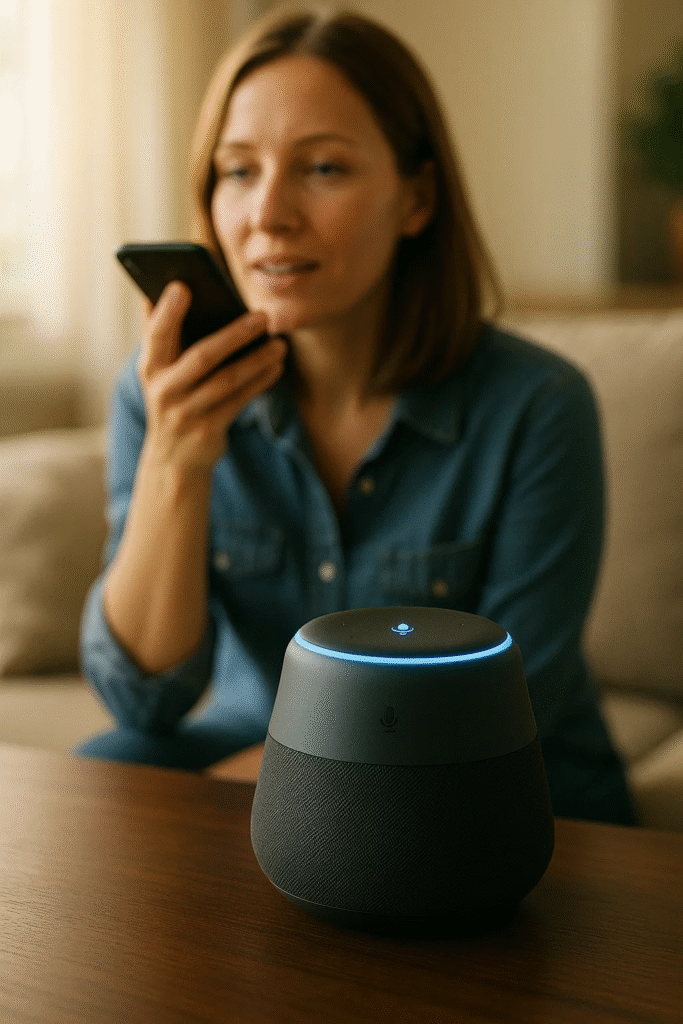Key Takeaways
- Voice assistants use AI, speech recognition, and natural language processing to interpret and respond to user voice commands.
- They are widely used in smart devices for tasks like setting reminders, controlling appliances, and retrieving information.
- Despite benefits like convenience and accessibility, challenges include privacy concerns and limited contextual understanding.
In today’s fast-evolving digital landscape, voice assistants have emerged as one of the most transformative and widely adopted technologies in both personal and professional environments. These intelligent virtual companions—integrated into smartphones, smart speakers, home automation systems, and even vehicles—are redefining the way humans interact with machines. From executing voice commands and answering questions to controlling smart home devices and providing real-time information, voice assistants have rapidly become indispensable tools for streamlining daily routines and enhancing user convenience.

A voice assistant, often referred to as a virtual assistant or smart assistant, is an AI-powered software application capable of understanding and responding to spoken language. By leveraging sophisticated technologies such as speech recognition, natural language processing (NLP), and machine learning, these systems can interpret verbal inputs, analyze context, and deliver accurate, human-like responses. Whether it’s Apple’s Siri, Amazon Alexa, Google Assistant, or Microsoft Cortana, each platform is designed to simplify user tasks through voice-controlled automation.
The rise of voice assistants is a direct reflection of the growing demand for hands-free, efficient, and intuitive digital interactions. As consumers increasingly prioritize speed and ease of access, voice-enabled technology is becoming deeply integrated into smart homes, wearable devices, customer service platforms, healthcare systems, and more. According to recent industry statistics, billions of voice assistant devices are in active use globally, and this number is expected to rise exponentially as advancements in artificial intelligence and voice interface design continue to evolve.
Understanding how voice assistants work is crucial for users, developers, and businesses aiming to harness the potential of this technology. Behind their seemingly simple and natural interface lies a complex architecture of algorithms and data-driven systems that process, interpret, and learn from user inputs. From detecting wake words to converting speech into actionable tasks, the underlying mechanisms are rooted in a blend of cutting-edge technologies such as deep learning, cloud computing, and real-time analytics.
Moreover, as voice assistants become more personalized and context-aware, they are not only facilitating user commands but also anticipating needs and delivering proactive support. This evolution signals a shift toward more intelligent and conversational user experiences that extend far beyond simple command execution.
This blog explores the essential components of voice assistants, from their foundational technologies and functionality to their practical applications and future potential. It provides an in-depth overview of what voice assistants are, how they operate behind the scenes, and why they are increasingly becoming integral to modern digital ecosystems. By delving into the mechanics and capabilities of these AI-driven tools, readers will gain a comprehensive understanding of the transformative impact of voice assistant technology in today’s connected world.
Before we venture further into this article, we would like to share who we are and what we do.
About 9cv9
9cv9 is a business tech startup based in Singapore and Asia, with a strong presence all over the world.
With over nine years of startup and business experience, and being highly involved in connecting with thousands of companies and startups, the 9cv9 team has listed some important learning points in this overview of What are Voice Assistants and How Do They Work.
If your company needs recruitment and headhunting services to hire top-quality employees, you can use 9cv9 headhunting and recruitment services to hire top talents and candidates. Find out more here, or send over an email to [email protected].
Or just post 1 free job posting here at 9cv9 Hiring Portal in under 10 minutes.
What are Voice Assistants and How Do They Work
- What is a Voice Assistant?
- A Brief History of Voice Assistants
- How Do Voice Assistants Work?
- Common Applications of Voice Assistants
- Benefits of Using Voice Assistants
- Challenges and Limitations
- The Future of Voice Assistant Technology
1. What is a Voice Assistant?
A voice assistant, also referred to as a virtual assistant or AI assistant, is an AI-powered software application designed to interpret and respond to human speech using natural language. These assistants act as digital intermediaries that can perform a wide range of tasks through voice commands, such as setting reminders, answering questions, managing schedules, controlling smart devices, and more. They rely on advanced technologies like natural language processing (NLP), machine learning, and voice recognition to deliver accurate and contextually relevant responses.
Definition and Core Purpose
• What Defines a Voice Assistant?
- A software system that uses speech recognition to receive input from users in the form of spoken commands.
- Converts spoken language into actionable tasks via natural language understanding (NLU) and AI algorithms.
- Provides auditory feedback or performs predefined actions, such as playing music, sending texts, or controlling IoT devices.
• Primary Purpose of Voice Assistants:
- To simplify human-computer interaction through conversational interfaces.
- To offer hands-free access to digital services and functionalities.
- To enhance productivity by automating everyday tasks and providing real-time information.
Popular Examples of Voice Assistants
Voice assistants are embedded in a variety of consumer devices and platforms, each offering unique features and ecosystem integrations:
• Amazon Alexa
- Found in Echo smart speakers and integrated into smart home systems.
- Can perform tasks such as shopping on Amazon, answering trivia, and controlling smart lights and thermostats.
• Apple Siri
- Built into iPhones, iPads, Apple Watch, HomePod, and macOS devices.
- Known for features like sending messages, navigating via Apple Maps, and integrating with Apple’s ecosystem (Calendar, Notes, etc.).
• Google Assistant
- Embedded in Android smartphones, Google Nest devices, and smart displays.
- Capable of searching the web, setting routines, and controlling smart home gadgets via Google Home.
• Microsoft Cortana (Now Business-Oriented)
- Originally built into Windows 10 and Microsoft products.
- Shifted focus towards enterprise productivity, especially within Microsoft 365 applications.
• Samsung Bixby
- Integrated into Samsung smartphones, TVs, and appliances.
- Designed for device control, content discovery, and personal assistance across Samsung’s ecosystem.
Key Features of Voice Assistants
Voice assistants vary in capabilities, but most share the following foundational features:
• Voice Activation and Wake Words
- Triggered by specific wake words like “Hey Siri,” “OK Google,” or “Alexa.”
- Always listening for activation but typically not recording until triggered.
• Speech Recognition
- Ability to convert spoken words into text using Automatic Speech Recognition (ASR) systems.
- Handles various accents, dialects, and background noise levels to maintain accuracy.
• Natural Language Understanding (NLU)
- Interprets user intent beyond simple keyword recognition.
- Allows users to speak naturally and still be understood effectively.
• Contextual Awareness
- Capable of remembering previous interactions to provide relevant, personalized responses.
- Adjusts replies based on location, device usage history, and user preferences.
• Task Execution
- Can perform a variety of tasks such as:
- Sending texts or emails
- Making phone calls
- Checking weather or traffic updates
- Playing music or podcasts
- Providing calendar alerts and reminders
Voice Assistants vs. Chatbots: Understanding the Difference
Though similar in function, voice assistants and chatbots serve different purposes and use different interaction models:
• Voice Assistants:
- Use speech-based input/output.
- Often multimodal, supporting audio, visual, and sometimes text-based outputs.
- Designed for complex, dynamic tasks including home automation, navigation, and search.
• Chatbots:
- Typically text-based interfaces found on websites and apps.
- Better suited for static, rule-based conversations such as FAQs or basic customer support.
- Do not usually include speech recognition or voice output capabilities.
Devices and Platforms that Use Voice Assistants
Voice assistants are integrated into a wide variety of devices to expand their usability:
• Smartphones and Tablets
- iOS (Siri), Android (Google Assistant), Samsung (Bixby)
• Smart Speakers and Displays
- Amazon Echo, Google Nest Hub, Apple HomePod
• Laptops and Desktops
- Windows (Cortana), macOS (Siri)
• Smart TVs and Appliances
- Samsung Smart TVs, LG ThinQ, Alexa-enabled ovens or fridges
• Automobiles
- Apple CarPlay and Android Auto integrations
- Amazon Alexa Auto for hands-free driving assistance
Why Voice Assistants Matter in the Modern Digital Ecosystem
Voice assistants are not just a convenience; they are reshaping digital experiences across industries:
• Enhanced Accessibility
- Assist individuals with disabilities or impairments by offering voice-driven alternatives to manual inputs.
• Smart Home Integration
- Central to the Internet of Things (IoT), allowing voice-controlled automation of home environments.
• Business and Productivity
- Used for scheduling, reminders, dictation, and even voice-based customer service.
• Emerging Technologies
- Voice interfaces are increasingly being used in AR/VR, healthcare, education, and e-commerce applications.
By understanding what a voice assistant is, users can better appreciate the capabilities and transformative potential of this technology in both personal and professional contexts. As voice AI continues to evolve, these systems are becoming more intelligent, more human-like, and more deeply embedded in everyday digital experiences.
2. A Brief History of Voice Assistants
The development of voice assistants represents a fascinating journey of technological innovation, from early speech recognition systems to the sophisticated, AI-driven virtual assistants we rely on today. Over the years, voice assistants have become more intelligent, accessible, and integrated into various devices, changing the way we interact with technology. This section provides a deep dive into the history of voice assistants, outlining key milestones and developments in their evolution.
Early Foundations: The Beginnings of Speech Recognition
• Pre-1960s: Early Research into Speech Recognition
- Speech synthesis and recognition were first explored in the 1950s, primarily in academic and military research.
- Bell Labs developed some of the earliest prototypes of speech recognition systems, but they were limited to recognizing a small set of words and phrases.
- The concept was largely theoretical, and significant technological advancements were needed to make voice interfaces practical.
• 1960s: IBM’s Shoebox
- One of the first commercially available speech recognition systems, IBM’s Shoebox was introduced in 1961.
- Shoebox could recognize 16 words and digits, making it a rudimentary example of the potential of voice technology.
- Though it was not widely adopted, it laid the foundation for future speech recognition systems.
The 1980s and 1990s: Pioneering Commercial Systems
• 1980s: Early Digital Voice Recognition
- Digital Equipment Corporation (DEC) launched “Voice Type”, a system capable of transcribing speech into text.
- These early systems still had limited vocabulary and were primarily used for specialized purposes in professional and academic fields.
• 1990s: Dragon Systems and Speech-to-Text Technology
- Dragon Systems, founded in 1992, became a key player in the development of speech recognition for the consumer market.
- In 1997, Dragon released Dragon NaturallySpeaking, the first speech recognition software that allowed users to control their computers and transcribe text simply by speaking.
- While these systems were a breakthrough in voice-to-text technology, they were not fully conversational or capable of understanding natural language.
2000s: The Birth of Virtual Assistants
• 2001: Microsoft’s Clippy and Office Assistant
- Microsoft introduced Clippy, the paperclip-shaped Office Assistant, in Microsoft Office 97, and later improved it in the 2000s.
- Although not a fully functional voice assistant, Clippy provided rudimentary conversational help and guided users in performing tasks.
- The interaction was heavily scripted and rule-based, but it represented an early attempt at creating an assistant that could understand user input in a more personalized manner.
• 2002: The Launch of Vlingo and Early Mobile Assistants
- In 2002, Vlingo was founded and developed one of the first mobile voice recognition apps.
- Vlingo allowed users to send messages, make calls, and perform other tasks on mobile phones through voice commands.
- This was a significant development for integrating voice assistants into mobile devices.
2010s: The Rise of Mainstream Virtual Assistants
• 2011: Apple’s Siri – The First True Voice Assistant
- Apple’s Siri, launched with the iPhone 4S in 2011, is widely considered the first true virtual assistant.
- Siri utilized natural language processing (NLP) and speech recognition to interpret user commands and respond in a conversational manner.
- Siri’s introduction marked a significant shift from simple voice recognition to AI-powered personal assistants capable of executing complex tasks.
- Early capabilities included setting reminders, sending messages, checking the weather, and searching the web.
• 2014: Amazon Alexa – The Smart Home Revolution
- In 2014, Amazon Echo, powered by Alexa, was released. Alexa brought voice assistant technology into the smart home environment.
- Alexa allowed users to control a wide range of smart home devices like lights, thermostats, and music, making it a key player in the Internet of Things (IoT).
- Skills, or third-party apps, were introduced to extend Alexa’s functionality, allowing users to access services like ordering food, playing games, or even controlling security systems.
• 2016: Google Assistant – Elevating AI Integration
- In 2016, Google launched Google Assistant, which was first integrated into its Pixel smartphones and later expanded to other devices such as smart speakers and Android devices.
- Google Assistant leveraged the company’s extensive search capabilities and AI-driven contextual understanding to offer richer, more accurate responses compared to its predecessors.
- It also integrated seamlessly with Google’s suite of services, including Google Maps, Gmail, and Google Calendar.
• 2017: Microsoft Cortana – Expanding Business Productivity
- While Cortana, launched by Microsoft in 2014, initially competed with Siri and Google Assistant in the consumer market, it shifted focus in 2017 towards enterprise productivity and integration with Microsoft’s Office 365 and Windows 10.
- Cortana aimed to be a productivity assistant, helping users manage tasks, meetings, and emails more efficiently in professional environments.
2020s and Beyond: The Future of Voice Assistants
• 2020: The Rise of Multimodal Voice Assistants
- Voice assistants began to evolve into multimodal systems, incorporating visual displays and touch interfacesalongside voice interaction.
- Devices like the Amazon Echo Show, Google Nest Hub, and Apple HomePod integrated touchscreens to complement voice commands, providing richer interactions.
• 2021 and Beyond: Integration in New Markets and Devices
- Voice assistants are increasingly becoming a part of automobiles, wearable devices, and healthcare products.
- For example, Apple CarPlay and Android Auto have integrated voice assistants into vehicles, allowing drivers to interact with their smartphones while keeping their hands on the wheel.
- In healthcare, virtual assistants are helping in areas like telemedicine, patient monitoring, and appointment scheduling.
• AI and Personalization: The Next Frontier
- The future of voice assistants lies in AI-driven personalization, where assistants can better understand individual preferences, habits, and voice patterns.
- Companies like Amazon and Google are focusing on making their assistants more context-aware, adapting responses based on user history and situational context.
Key Takeaways from the History of Voice Assistants
- The development of voice assistants has been marked by decades of research and technological breakthroughsin areas such as speech recognition, natural language processing, and machine learning.
- The shift from simple speech-to-text systems to conversational AI marked the turning point in making voice assistants truly useful for a wide range of tasks.
- Today’s voice assistants, such as Alexa, Siri, Google Assistant, and Cortana, are deeply integrated into everyday life and industries, from home automation to business productivity.
- Looking forward, voice assistants are poised to become even more intelligent, personalized, and multimodal, driving even more widespread adoption across various sectors.
3. How Do Voice Assistants Work?
Voice assistants, powered by sophisticated algorithms and artificial intelligence (AI), have transformed the way users interact with technology. Whether it’s Siri, Alexa, or Google Assistant, these virtual assistants rely on a combination of various technologies, such as speech recognition, natural language processing (NLP), and machine learning to function seamlessly. This section delves into the underlying technologies and processes that make voice assistants work.
1. The Core Technology Behind Voice Assistants
Voice assistants rely on a set of foundational technologies that enable them to understand, process, and respond to voice commands. These technologies include speech recognition, natural language processing (NLP), and text-to-speech (TTS). Let’s explore each one in detail.
• Speech Recognition
- Speech recognition is the process of converting spoken language into text, which is then processed and interpreted by the assistant.
- The first step is to capture the user’s voice, which is done via microphones in devices like smartphones, smart speakers, and wearables.
- Once the speech is recorded, algorithms break it down into phonemes—the smallest units of sound—before converting them into text.
- For example, when a user says, “Hey Siri, what’s the weather today?” the assistant first converts the spoken words into a text-based query for further analysis.
• Natural Language Processing (NLP)
- NLP enables voice assistants to understand and interpret human language in a meaningful way.
- NLP breaks down the text into smaller components, such as:
- Intent Recognition: Understanding what the user is asking or requesting.
- Entity Recognition: Identifying key elements such as dates, locations, names, etc., in the user’s request.
- For example, in the command “Turn off the living room lights,” NLP identifies:
- Intent: Turn off
- Entity: Living room lights
- This step is crucial for understanding natural language, which is often ambiguous or context-dependent.
• Machine Learning and AI
- Machine learning (ML) allows voice assistants to learn from user interactions and improve over time.
- Training: The assistant is trained on large datasets to recognize various speech patterns, accents, and colloquialisms.
- Over time, the more a user interacts with their voice assistant, the better it becomes at recognizing speech and understanding context.
- For example, Google Assistant improves its performance by learning a user’s speech patterns and preferences, such as their preferred weather forecast service or news outlet.
2. Processing User Input
Once the voice assistant has captured and transcribed the user’s speech, the next step involves processing that input to determine the appropriate action or response.
• Speech-to-Text Conversion
- The first step in the processing pipeline is converting the audio recording into text using speech-to-text (STT)algorithms.
- Advanced models, such as those used by Google Assistant or Amazon Alexa, utilize neural networks trained on massive datasets to ensure high accuracy.
- For example, when a user says, “Play some jazz music,” the speech is converted into a query text such as “play jazz music.”
• Understanding the Query
- Once the speech is converted to text, the assistant uses NLP to analyze and interpret the query.
- It performs tasks such as:
- Intent classification: Determining what the user wants to achieve (e.g., setting an alarm, making a phone call, controlling smart devices).
- Entity extraction: Identifying relevant entities such as people, locations, or times.
- For example, in the query “Set an alarm for 7 a.m.,” the intent is set an alarm, and the entity is 7 a.m..
• Contextual Understanding
- Context plays a vital role in making voice assistants more intelligent and accurate.
- Context includes factors such as:
- The user’s previous interactions with the assistant.
- The location of the user (e.g., asking about local weather).
- Time of day (e.g., distinguishing between “Play music” in the morning versus the evening).
- Voice assistants leverage contextual awareness to provide more relevant and personalized responses.
3. Retrieving the Appropriate Response
After interpreting the user’s query, the voice assistant must retrieve the correct information and deliver it to the user. This is where AI and access to vast databases come into play.
• Integration with Databases and APIs
- Voice assistants have access to vast databases and services, which they tap into when retrieving information. For example:
- Google Assistant accesses Google’s search engine and databases to provide answers.
- Amazon Alexa connects with third-party skills to control smart home devices, order food, or provide entertainment.
- Apple Siri uses a variety of sources, including Apple’s ecosystem, to perform tasks.
• Action Execution
- For many commands, voice assistants can also execute tasks directly, such as:
- Turning on lights (via smart home integration).
- Sending messages or making calls.
- Playing music or podcasts.
- For example, when the user says “Play ‘Bohemian Rhapsody’ on Spotify,” the assistant uses Spotify’s API to stream the song.
• Personalization
- Over time, voice assistants become increasingly personalized to the user’s needs and preferences.
- For example, Alexa can recognize a family’s voice profiles and offer personalized recommendations based on previous interactions.
- Google Assistant provides customized news updates and reminders based on a user’s interests.
4. Responding to the User
Once the assistant has processed the input and determined the appropriate action, it needs to communicate the result to the user. This involves text-to-speech (TTS) technology.
• Text-to-Speech (TTS) Technology
- Text-to-speech (TTS) is used to convert the assistant’s response from text back into natural-sounding speech.
- Advanced TTS systems, such as those used by Siri, Google Assistant, and Alexa, employ neural networks to generate speech that sounds more human-like.
- For instance, when asking Siri, “What’s the time?” the assistant will respond with a natural-sounding, human-like voice.
• Error Handling and Feedback
- In case of errors or confusion, voice assistants are designed to handle unexpected situations. They might ask the user for clarification or suggest alternatives.
- For example, if a user says “Call John,” but the assistant finds multiple entries, it might reply, “Which John would you like to call? John Smith or John Doe?”
5. Examples of Voice Assistants in Action
To better understand how voice assistants work, let’s explore some examples of real-world applications.
• Apple Siri
- Siri uses a combination of local processing (on the device) and cloud-based processing to interpret and respond to queries.
- Siri can perform tasks such as sending messages, setting reminders, answering questions, and controlling smart home devices.
• Amazon Alexa
- Alexa is deeply integrated into the smart home ecosystem, allowing users to control lights, thermostats, and security systems via voice.
- Alexa’s integration with third-party skills enables a vast array of tasks, from ordering pizza to finding nearby restaurants.
• Google Assistant
- Google Assistant excels at contextual search, offering personalized responses based on the user’s search history and preferences.
- For example, asking Google Assistant “What’s the weather like?” will provide the forecast based on the user’s location.
Conclusion: The Complex Mechanism of Voice Assistants
Voice assistants are highly sophisticated systems that combine various advanced technologies to provide seamless, interactive experiences for users. The process of converting speech to text, interpreting natural language, executing commands, and delivering responses is an intricate one that depends on machine learning, AI, and vast databases. As voice assistants continue to evolve, we can expect even more accurate, personalized, and intuitive interactions in the future.
4. Common Applications of Voice Assistants
Voice assistants have become integral parts of modern life, with applications spanning across different sectors and industries. From personal use to enterprise solutions, voice assistants provide unparalleled convenience by enabling hands-free interaction with devices and systems. This section explores the most common applications of voice assistants, with relevant examples that demonstrate their utility in everyday life.
1. Personal Assistance
Voice assistants serve as highly effective personal assistants, helping users manage their day-to-day activities with minimal effort. Their ability to perform a range of tasks from setting reminders to managing calendars makes them essential tools for many individuals.
• Setting Reminders and Alarms
- Users can easily set reminders for important tasks, events, or appointments, which voice assistants remind them of at the appropriate time.
- Example: “Alexa, remind me to call mom at 3 PM” or “Hey Siri, set an alarm for 7 AM.”
• Managing Schedules
- Voice assistants can integrate with calendars (Google, Outlook, etc.) to schedule, reschedule, and manage appointments.
- Example: “Google Assistant, add a meeting with John at 10 AM tomorrow” or “Siri, what’s on my calendar for today?”
• Answering Questions
- Voice assistants can provide quick answers to general knowledge queries, such as facts, definitions, and trivia.
- Example: “What’s the capital of Japan?” or “Who won the Oscar for Best Picture in 2021?”
• Providing Weather and Traffic Updates
- Voice assistants deliver real-time weather forecasts and traffic conditions, which help users plan their daily activities more effectively.
- Example: “Alexa, what’s the weather like today?” or “Google Assistant, what’s the traffic like on my way to work?”
2. Smart Home Control
One of the most popular applications of voice assistants is their integration with smart home devices. Through voice commands, users can control various aspects of their home environment, increasing convenience and energy efficiency.
• Lighting Control
- Voice assistants can control the lighting in your home by adjusting brightness, color, or even turning lights on/off.
- Example: “Alexa, turn off the living room lights” or “Hey Siri, set the bedroom lights to warm white.”
• Temperature Control
- Voice assistants can integrate with smart thermostats to adjust the temperature, ensuring comfort at home.
- Example: “Google Assistant, set the temperature to 72°F” or “Alexa, increase the temperature by 2 degrees.”
• Smart Appliances
- Users can interact with a variety of smart appliances, including refrigerators, washing machines, and coffee makers, via voice assistants.
- Example: “Siri, preheat the oven to 350 degrees” or “Alexa, start the dishwasher.”
• Security Systems
- Voice assistants can also control smart home security systems, including door locks, cameras, and alarms, providing an extra layer of convenience and safety.
- Example: “Alexa, lock the front door” or “Hey Google, show me the front door camera.”
3. Entertainment and Media Control
Voice assistants have become central hubs for controlling entertainment systems. Whether it’s playing music, podcasts, or controlling video streaming services, voice assistants provide a hands-free and intuitive way to enjoy media.
• Music and Podcasts
- Voice assistants can stream music, radio stations, and podcasts directly from various platforms such as Spotify, Apple Music, or Audible.
- Example: “Alexa, play some jazz music” or “Hey Siri, play the latest episode of ‘The Daily’ podcast.”
• Smart TVs and Streaming Services
- Voice assistants are integrated with smart TVs, allowing users to play movies and TV shows or control playback functions without needing a remote.
- Example: “Google Assistant, play Stranger Things on Netflix” or “Alexa, pause the movie.”
• Audiobooks
- Voice assistants can read aloud audiobooks, which users can listen to while performing other tasks.
- Example: “Siri, play ‘The Alchemist’ on Audible” or “Alexa, read the next chapter of my audiobook.”
4. Navigation and Travel Assistance
Voice assistants are valuable travel companions, helping users with navigation, flight details, hotel bookings, and more. They provide real-time information, making travel more efficient and less stressful.
• GPS and Navigation
- Voice assistants integrated with mapping apps (Google Maps, Apple Maps, Waze) offer turn-by-turn directions, traffic alerts, and route optimization.
- Example: “Hey Google, get directions to the nearest gas station” or “Alexa, how long will it take to drive to the airport?”
• Flight Information
- Voice assistants can check flight statuses, provide boarding details, and even help with booking tickets.
- Example: “Siri, when is my flight to New York?” or “Alexa, is my flight on time?”
• Hotel and Restaurant Reservations
- Many voice assistants can assist in booking accommodations, making restaurant reservations, and providing recommendations.
- Example: “Alexa, book a table for two at The Bistro at 7 PM” or “Google Assistant, find a hotel near the airport.”
5. Shopping and E-Commerce
Voice assistants have transformed the e-commerce landscape by enabling users to make purchases, track deliveries, and manage shopping lists hands-free.
• Making Purchases
- Voice assistants integrated with shopping platforms like Amazon allow users to place orders, add items to their cart, or track shipments with simple commands.
- Example: “Alexa, order more toothpaste” or “Hey Google, add paper towels to my shopping list.”
• Product Recommendations
- Voice assistants can recommend products based on user preferences, past purchases, or shopping habits.
- Example: “Siri, what’s the best smartphone in 2024?” or “Google Assistant, recommend a gift for my wife’s birthday.”
• Price Comparison
- Users can ask voice assistants for information about the price or availability of products, allowing them to compare prices across various platforms.
- Example: “Alexa, is this product available in my size?” or “Hey Siri, find me the cheapest flight to Paris.”
6. Accessibility and Assistance for People with Disabilities
Voice assistants play a vital role in making technology accessible for individuals with disabilities. They provide voice-activated control over devices and services, promoting independence and convenience.
• Speech-to-Text
- Voice assistants convert speech to text, enabling individuals with hearing impairments or those unable to type to communicate more easily.
- Example: “Siri, send a message to John saying I’m running late.”
• Hands-Free Control
- For people with limited mobility, voice assistants provide hands-free control over their home and devices.
- Example: “Alexa, close the blinds” or “Hey Google, turn on the lights in the kitchen.”
• Assistance for Visually Impaired
- Voice assistants assist individuals with visual impairments by reading aloud information, navigating devices, or even identifying objects in the environment.
- Example: “Siri, read the text on my screen” or “Google Assistant, what’s the temperature outside?”
7. Healthcare and Wellness
Voice assistants are increasingly being integrated into healthcare, where they help with medication management, tracking fitness goals, and offering health-related advice.
• Medication Reminders
- Voice assistants can remind users when it’s time to take their medication, ensuring better adherence to prescribed schedules.
- Example: “Alexa, remind me to take my medication at 8 AM.”
• Fitness Tracking and Goals
- Integration with fitness apps and wearables allows voice assistants to help users set, track, and meet their fitness goals.
- Example: “Hey Google, how many steps have I taken today?” or “Siri, start my morning workout routine.”
• Health Monitoring
- Voice assistants can provide guidance on lifestyle changes, including diet and sleep management.
- Example: “Alexa, what’s the ideal sleep duration for an adult?”
8. Business and Enterprise Solutions
Voice assistants are increasingly being used in business and enterprise settings, streamlining workflows, and improving productivity.
• Meeting Scheduling and Reminders
- In professional environments, voice assistants are used to schedule meetings, send reminders, and manage time efficiently.
- Example: “Alexa, schedule a team meeting for 2 PM tomorrow.”
• Customer Service
- Many businesses are integrating voice assistants into their customer service channels, allowing customers to inquire about services, make appointments, or check the status of an order.
- Example: “Siri, check the status of my customer support request.”
• Automation of Routine Tasks
- Businesses use voice assistants to automate repetitive tasks, such as sending reports, responding to emails, or retrieving specific data.
- Example: “Hey Google, send the monthly sales report to the team.”
Conclusion: The Growing Impact of Voice Assistants
Voice assistants are versatile and constantly evolving tools that simplify many aspects of everyday life. From personal assistance to smart home control, shopping, healthcare, and enterprise applications, voice assistants continue to improve how we interact with technology. As their capabilities expand, we can expect voice assistants to play an even greater role in enhancing productivity, convenience, and accessibility in our daily routines.
5. Benefits of Using Voice Assistants
Voice assistants have transformed how we interact with technology, offering convenience, efficiency, and new ways to improve productivity across various sectors. The integration of voice recognition and artificial intelligence in daily tasks has led to significant advantages for both individuals and businesses. This section will explore the numerous benefits of using voice assistants, providing examples to showcase their impact in various contexts.
1. Enhanced Convenience
One of the most compelling reasons people use voice assistants is the convenience they offer. Voice interaction allows users to perform tasks without needing to physically interact with a device, enabling multitasking and improving overall efficiency.
• Hands-Free Operation
- Voice assistants allow users to complete tasks while their hands are occupied, ideal for situations like cooking, driving, or exercising.
- Example: “Alexa, set a timer for 20 minutes” while cooking or “Hey Siri, call John” while driving.
• Quick Access to Information
- With voice commands, information such as weather updates, news, and general queries are instantly available, saving time compared to traditional searching methods.
- Example: “Google Assistant, what’s the latest news in tech?” or “Alexa, what’s the weather forecast for today?”
• Simplified Device Control
- Voice assistants make it easier to control various devices within a smart home ecosystem, including lights, thermostats, and security cameras, all through simple voice commands.
- Example: “Hey Google, dim the living room lights” or “Alexa, lock the front door.”
2. Improved Productivity
Voice assistants are highly beneficial for increasing productivity, especially in busy environments where multitasking is essential. They help with organizing daily tasks, managing schedules, and providing reminders to stay on track.
• Time Management and Scheduling
- Voice assistants can schedule meetings, set reminders, and even check calendars, enabling users to stay organized with minimal effort.
- Example: “Siri, schedule a meeting with Mark for 3 PM tomorrow” or “Alexa, add a dentist appointment to my calendar.”
• Task Automation
- Routine tasks such as setting alarms, sending messages, or making calls can be automated using voice assistants, freeing up time for more critical tasks.
- Example: “Hey Google, send an email to Sarah confirming our meeting” or “Alexa, add milk to the shopping list.”
• Task Delegation
- Voice assistants can assist in delegating tasks and handling routine administrative duties, especially useful in professional settings.
- Example: “Siri, remind me to send the report to the client by noon” or “Google Assistant, make a reservation for four at 7 PM.”
3. Accessibility and Inclusivity
Voice assistants play a crucial role in improving accessibility for individuals with disabilities, offering equal opportunities for those with limited mobility, hearing, or vision impairments.
• Assistance for the Visually Impaired
- Voice assistants read out text and interact with smart devices, making it easier for visually impaired individuals to access information and control their environment.
- Example: “Siri, read the text on my screen” or “Alexa, what does this text say?”
• Support for People with Limited Mobility
- Users with limited hand mobility can use voice commands to control various devices, such as adjusting the thermostat, lighting, or playing music.
- Example: “Hey Google, set the temperature to 70 degrees” or “Alexa, play my favorite playlist.”
• Speech-to-Text Features
- Voice assistants provide speech-to-text capabilities that benefit people who find typing difficult due to physical disabilities or conditions like dyslexia.
- Example: “Hey Siri, send a message to Sam saying I’ll be late” or “Google Assistant, dictate an email to Mike.”
4. Increased Safety
Voice assistants help enhance safety, especially in situations where manual interaction with devices may be risky, such as while driving or cooking.
• Voice-Activated Control for Drivers
- Voice assistants enable hands-free phone calls, navigation, and media control, allowing drivers to stay focused on the road while still interacting with their devices.
- Example: “Hey Google, navigate to the nearest gas station” or “Alexa, play some road trip music.”
• Increased Safety in the Kitchen
- Cooking can be hazardous, but voice assistants reduce the need for physical interaction with devices by setting timers, controlling appliances, and finding recipes.
- Example: “Alexa, set a timer for 30 minutes” or “Google Assistant, find a recipe for lasagna.”
• Home Security Control
- Voice assistants integrate with smart security systems, allowing users to monitor and control home security devices without needing to manually engage with apps or alarms.
- Example: “Alexa, show me the front door camera” or “Google Assistant, arm the security system.”
5. Cost-Effectiveness
Voice assistants can lead to cost savings in several areas, particularly when integrated into smart home ecosystems and business operations.
• Energy Efficiency
- By controlling devices such as lights, thermostats, and smart plugs, voice assistants can help reduce energy consumption, leading to cost savings on utility bills.
- Example: “Hey Google, turn off the lights in the kitchen” or “Alexa, lower the thermostat by 5 degrees.”
• Efficient Resource Management
- Businesses and individuals can optimize resource usage and improve workflows through task automation and better management of daily activities.
- Example: “Siri, remind me to send the invoices to the clients” or “Google Assistant, schedule a weekly check on inventory levels.”
• Reduced Need for Human Labor in Business Operations
- In the workplace, voice assistants can automate customer service, answering frequently asked questions and providing round-the-clock assistance, reducing the need for human agents.
- Example: “Alexa, what are your store hours?” or “Hey Google, assist customers with tracking their orders.”
6. Multitasking and Efficiency
Voice assistants help users perform multiple tasks at once without having to divide their attention between several devices, making everyday activities more efficient.
• Simultaneous Task Execution
- With voice commands, users can execute several actions at once, such as checking the weather while preparing a shopping list, or listening to a podcast while working out.
- Example: “Alexa, add eggs to the shopping list and play some jazz music” or “Hey Google, tell me the traffic report and send an email.”
• Increased Focus on Primary Tasks
- Voice assistants can help users stay focused on their primary tasks by performing smaller, distracting activities in the background, such as setting timers or making calls.
- Example: “Siri, call my office while I finish this report” or “Google Assistant, set a 10-minute timer for me.”
• No Need for Physical Interaction
- Users can continue with other activities without having to physically interact with devices, whether it’s managing smart home devices, setting up reminders, or controlling media.
- Example: “Hey Siri, play the podcast I was listening to” or “Alexa, dim the lights while I finish this presentation.”
7. Integration with Third-Party Applications
Voice assistants can integrate with various third-party applications and services, enhancing their functionality and providing a more seamless user experience.
• Integration with Streaming Services
- Voice assistants are integrated with popular streaming platforms, allowing users to play music, watch videos, or listen to podcasts via voice commands.
- Example: “Hey Google, play the latest episode of ‘Serial’ on Spotify” or “Alexa, play ‘Avengers: Endgame’ on Netflix.”
• Smart Home Ecosystem Integration
- Voice assistants are compatible with a wide range of smart home devices, including lights, security systems, thermostats, and appliances, creating a more connected and efficient living environment.
- Example: “Google Assistant, lock all doors” or “Siri, set the thermostat to 72°F.”
• App and Service Integration
- With integrations to apps like Uber, food delivery services, or task management tools, voice assistants can simplify a wide range of services.
- Example: “Alexa, order my usual from Starbucks” or “Google Assistant, book an Uber to the airport.”
8. Entertainment and Fun
Voice assistants also offer a range of entertainment and leisure activities that can enhance the user experience, from playing games to telling jokes or reading stories.
• Interactive Games
- Voice assistants provide a variety of interactive games that users can play hands-free, whether alone or with family and friends.
- Example: “Alexa, play a trivia game” or “Hey Google, let’s play 20 questions.”
• Jokes, Fun Facts, and Stories
- For entertainment, voice assistants can tell jokes, share fun facts, or read stories to engage users.
- Example: “Siri, tell me a joke” or “Alexa, tell me a fun fact.”
• Music and Movie Recommendations
- Voice assistants provide personalized recommendations for music, TV shows, movies, and podcasts, based on user preferences.
- Example: “Google Assistant, play my workout playlist” or “Alexa, recommend a good movie to watch tonight.”
Conclusion: The Multifaceted Benefits of Voice Assistants
The benefits of using voice assistants go far beyond convenience. They offer productivity enhancements, greater accessibility, increased safety, cost savings, and seamless integration with smart devices and third-party applications. As technology continues to advance, the role of voice assistants will undoubtedly expand, offering even more advantages in both personal and professional contexts.
6. Challenges and Limitations
While voice assistants offer numerous benefits, there are several challenges and limitations that users may encounter. From privacy concerns to issues with accuracy and device compatibility, it is important to understand the potential drawbacks of relying on these technologies. This section will delve into the key challenges associated with voice assistants, highlighting real-world examples and the impact on both individuals and businesses.
1. Privacy and Security Concerns
One of the most significant challenges associated with voice assistants is the potential invasion of privacy. As voice assistants constantly listen for commands, there is a risk that personal data may be inadvertently recorded or misused.
• Constant Listening
- Most voice assistants are always “on,” listening for a wake word (e.g., “Hey Siri,” “Alexa,” “Ok Google”). This means they could potentially capture private conversations or personal information.
- Example: There have been instances where devices like Amazon Echo have mistakenly recorded private conversations without the user’s knowledge, sending them to unintended recipients.
• Data Collection and Usage
- Voice assistants often collect a significant amount of data, including voice recordings, search history, and user preferences, which could be used for targeted advertising or sold to third-party companies.
- Example: Google and Amazon have faced scrutiny over the collection and use of voice data for advertising and marketing purposes, leading to concerns about user privacy.
• Hacking and Unauthorized Access
- Voice assistants are vulnerable to hacking and unauthorized access, which can result in security breaches or theft of sensitive information. Even with strong security measures, there is always the risk of exploitation.
- Example: In 2018, security researchers demonstrated that hackers could trick voice assistants into unlocking devices or making purchases by using recorded voices.
2. Accuracy and Misunderstandings
Although voice recognition technology has advanced significantly, voice assistants are still prone to inaccuracies, particularly when it comes to understanding accents, languages, or ambiguous commands.
• Misinterpretation of Commands
- Voice assistants may misinterpret commands, especially if the user’s accent, speech patterns, or pronunciation is not well understood by the system.
- Example: A user with a strong regional accent may find that a voice assistant consistently misunderstands certain words or phrases, leading to frustration and inefficiency.
• Background Noise Interference
- Voice assistants struggle in noisy environments, where background sounds can interfere with the device’s ability to accurately detect and process commands.
- Example: If a user tries to interact with a voice assistant in a crowded or noisy room, the system might fail to understand the command or misinterpret it entirely.
• Limited Contextual Understanding
- Voice assistants often have limited contextual awareness, which means they may fail to understand nuanced requests or remember past interactions accurately.
- Example: If a user says, “Set a reminder to call John tomorrow,” and then later asks, “What was the reminder for?” the assistant may not provide a useful or relevant response.
3. Limited Functionality and Integration
While voice assistants have become more capable, there are still significant limitations in terms of functionality and integration with third-party services or smart devices.
• Compatibility with Devices
- Not all smart devices are compatible with voice assistants, and users may face challenges integrating different brands or models into a single smart home ecosystem.
- Example: Some users may find that their smart lights from one brand do not work seamlessly with their voice assistant, requiring additional apps or settings for integration.
• Limited Commands for Specialized Tasks
- Voice assistants are generally designed for general tasks, but they may struggle with more specialized or industry-specific functions, limiting their utility in certain contexts.
- Example: While voice assistants can easily schedule a meeting or provide a weather update, they may not be able to handle complex project management tasks, such as updating a Gantt chart or generating financial reports.
• Lack of Multilingual Support
- Although many voice assistants support multiple languages, they often struggle with handling multiple languages in the same conversation or switching languages fluidly.
- Example: Users who speak multiple languages may find that their voice assistant struggles to switch between languages during the same conversation, leading to confusion or errors.
4. Dependence on Internet Connectivity
Voice assistants rely heavily on a stable internet connection for most of their functions. Without a connection, the performance and capabilities of these devices are significantly limited.
• Limited Offline Functionality
- While some voice assistants have limited offline capabilities (e.g., setting timers or controlling local devices), the majority of their features require an internet connection to function fully.
- Example: A user might not be able to ask their voice assistant for a weather update or perform web searches when their internet connection is down.
• Reliability of Internet Connection
- In areas with poor internet connectivity, voice assistants may become unreliable or unresponsive, which can disrupt daily activities or workflows.
- Example: A user in a rural area with limited internet access may find that their voice assistant frequently fails to perform tasks or provide real-time updates due to a weak connection.
5. Battery and Power Limitations
Voice assistants, particularly those integrated into portable devices like smartphones or smart speakers, are limited by battery life, which can affect their usability and functionality.
• Battery Drain
- Continuous listening and processing can drain the battery of portable voice assistant devices, especially when used frequently or with features like voice calling, music streaming, or smart home control.
- Example: A user who relies on their voice assistant for multiple tasks throughout the day might find that their smart speaker or phone’s battery runs out faster than expected.
• Power Supply for Smart Devices
- For voice assistants integrated into smart home devices (e.g., smart thermostats, cameras, or door locks), a power outage or failure can render them inoperable until power is restored.
- Example: A power outage may disable a voice assistant’s ability to control smart lights or adjust the thermostat, affecting the convenience and efficiency that users typically rely on.
6. User Dependency and Over-Reliance
As voice assistants become more integrated into daily life, users may become overly dependent on these devices, which could lead to a loss of certain skills and a decrease in problem-solving abilities.
• Reduced Cognitive Engagement
- Excessive reliance on voice assistants for routine tasks might result in users becoming less engaged in critical thinking and memory recall, relying on the assistant for reminders, information, and scheduling.
- Example: A person who constantly asks, “What time is my meeting?” instead of remembering it might eventually struggle with time management skills or memory retention.
• Diminished Self-Sufficiency
- Some users may find themselves less self-sufficient, relying too heavily on voice assistants for even simple tasks, such as setting an alarm, playing music, or getting information.
- Example: A user might rely on a voice assistant to find directions to a nearby restaurant rather than learning how to navigate using a map app themselves.
7. Ethical and Social Implications
The widespread adoption of voice assistants brings forth various ethical and social concerns related to privacy, surveillance, and the impact of technology on human interaction.
• Privacy Invasion and Data Surveillance
- As voice assistants collect vast amounts of data on users, there are ethical concerns about the extent of surveillance and whether users are fully aware of the data being collected and how it’s used.
- Example: Voice assistants could potentially be used to monitor individuals’ behavior, habits, and preferences, raising concerns about data misuse or unauthorized surveillance.
• Impact on Human Interaction
- Over-reliance on voice assistants may contribute to a reduction in face-to-face human interaction, leading to social isolation or a decline in interpersonal communication skills.
- Example: People may find themselves relying on voice assistants for companionship or entertainment instead of engaging in social activities with friends or family members.
• Bias and Inequality in AI Systems
- Voice assistants, like other AI technologies, are trained on data sets that may reflect societal biases, leading to issues such as misinterpretation of commands or unequal service delivery across different demographics.
- Example: Studies have shown that some voice assistants have difficulty understanding non-native accents or may respond differently to voices based on gender or ethnicity, leading to biased experiences.
Conclusion: Navigating the Challenges of Voice Assistants
While voice assistants provide numerous benefits, understanding their challenges and limitations is crucial to making informed decisions about their use. Issues such as privacy concerns, misinterpretations, and dependency on internet connectivity are significant factors to consider. By recognizing these challenges, users can better navigate the potential drawbacks while still leveraging the advantages these technologies offer.
7. The Future of Voice Assistant Technology
As artificial intelligence continues to evolve, voice assistant technology is undergoing a dramatic transformation. The future promises smarter, more intuitive, and more personalized voice assistants that integrate seamlessly into our everyday lives. From enhanced natural language processing to widespread integration with smart ecosystems, the advancements in this field will redefine how people interact with technology.
1. Advancements in Natural Language Processing (NLP)
Natural Language Processing will be the foundation of next-generation voice assistants, allowing them to understand human speech with greater nuance, context, and accuracy.
• Contextual Awareness
- Future voice assistants will better understand conversations based on past interactions and situational context.
- They will be able to hold more fluid, back-and-forth conversations, mimicking human-like dialogues.
- Example: A user can say, “Remind me to do that thing tomorrow,” and the assistant will recall the previous conversation and understand what “that thing” refers to.
• Multilingual and Code-Switching Capabilities
- Voice assistants will support seamless transitions between languages within a single conversation.
- Example: A bilingual user speaking in English and Spanish will no longer have to adjust settings; the assistant will adapt in real time.
• Emotional Intelligence and Sentiment Analysis
- AI will be trained to recognize tone, mood, and emotional cues in voice.
- Responses will be tailored based on how the user sounds—whether stressed, happy, or confused.
2. Hyper-Personalization and Predictive Assistance
Future voice assistants will not only respond to commands but also predict user needs and personalize interactions based on habits, preferences, and behaviors.
• User Behavior Learning
- AI will analyze routines, preferences, and calendar patterns to proactively offer suggestions or take action.
- Example: The assistant might say, “It looks like your 9 AM meeting was cancelled. Would you like to use this time for your weekly report?”
• Profile Customization
- Multiple user profiles will be supported on the same device with personalized voice recognition.
- Example: A smart speaker will differentiate between household members and tailor responses accordingly—like playing personalized playlists or providing specific calendar updates.
• Health and Wellness Integration
- Voice assistants will monitor user health metrics, suggest lifestyle improvements, and schedule doctor appointments.
- Example: Integration with wearables like Fitbit or Apple Watch could allow assistants to suggest water intake or remind users to move based on sedentary time.
3. Deeper Integration with Smart Ecosystems
Voice assistants will become central to fully interconnected smart homes, smart offices, and even smart cities.
• Smart Home Orchestration
- Voice assistants will serve as central hubs for managing all connected devices: thermostats, lights, security cameras, appliances, and more.
- Example: A command like “I’m going to bed” could trigger a scene—dimming lights, locking doors, adjusting the thermostat, and activating the alarm system.
• Automotive Integration
- Next-gen vehicles will come equipped with intelligent voice assistants to offer hands-free navigation, infotainment, and car diagnostics.
- Example: Tesla and BMW are incorporating AI-driven voice control systems that offer not only commands but also proactive safety alerts.
• Workplace and Industrial Use Cases
- Voice assistants will automate workflows, manage schedules, and offer instant access to data in professional environments.
- Example: In warehouses, voice assistants may guide workers through inventory picking using real-time voice commands integrated with backend systems.
4. Expansion into New Industries and Use Cases
The application of voice technology will expand well beyond consumer usage, disrupting industries like healthcare, education, and retail.
• Healthcare and Telemedicine
- Doctors and patients will interact with voice assistants for scheduling, symptom checking, and accessing medical records.
- Example: Mayo Clinic and other hospitals are integrating Alexa-based systems for post-operative care instructions and symptom monitoring.
• Education and E-Learning
- Voice assistants will serve as digital tutors, helping students with learning support, language practice, and homework assistance.
- Example: Platforms like Google Assistant are being used in classrooms to help young learners with spelling, math, and interactive quizzes.
• Retail and E-Commerce
- Retailers will leverage voice commerce to streamline shopping experiences, enabling users to search, order, and track products hands-free.
- Example: Walmart and Amazon are investing in voice-based shopping, where customers can add items to their cart, get price comparisons, and complete purchases using voice commands.
5. Enhanced Privacy and Ethical AI Design
Addressing security, bias, and data handling issues will be critical for the mainstream adoption of future voice assistants.
• On-Device Processing
- Processing commands locally (instead of sending data to the cloud) will increase privacy and reduce latency.
- Example: Apple’s Siri is transitioning toward more on-device processing for basic commands like setting timers or opening apps.
• Granular Data Controls
- Users will have more visibility and control over what data is collected and how it is used.
- Example: Voice assistants will provide prompts like, “Would you like me to save this conversation to improve future responses?”
• Ethical AI Development
- Developers will prioritize reducing algorithmic bias and enhancing inclusivity for diverse languages, accents, and cultural contexts.
- Example: Companies like Google and Microsoft are investing in more inclusive data training sets to reduce misrecognition errors in underrepresented speech patterns.
6. Evolution Toward Multimodal Interfaces
Voice assistants will increasingly integrate with visual and tactile interfaces, allowing users to interact through multiple modes of communication.
• Voice + Display Devices
- Devices with screens will combine visual feedback with spoken responses for a richer user experience.
- Example: Amazon Echo Show and Google Nest Hub allow users to view recipes, calendars, and video calls while interacting via voice.
• Gesture and Touch Integration
- Assistants will recognize gestures and combine them with voice input for enhanced control.
- Example: A user might wave a hand in front of a device to pause a video while saying, “Lower the volume.”
• Augmented and Virtual Reality Integration
- In AR/VR environments, voice assistants will guide users, provide contextual help, and enhance virtual collaboration.
- Example: In enterprise AR platforms, voice commands could be used to control digital interfaces during remote training sessions or virtual meetings.
7. Global Expansion and Accessibility
As infrastructure improves, voice assistants will reach more users across developing regions and offer increased accessibility to those with disabilities.
• Language and Dialect Expansion
- Support for regional dialects and lesser-spoken languages will make voice technology more inclusive globally.
- Example: Google Assistant has expanded to support over 40 languages and is working to add more regional dialects across Africa and Southeast Asia.
• Accessibility for Users with Disabilities
- Voice assistants will empower individuals with visual, mobility, or cognitive impairments to access services independently.
- Example: For people with mobility challenges, issuing commands via voice to control household devices can enable greater independence and quality of life.
Conclusion: A Smarter, More Human-Centric Future for Voice Assistants
The future of voice assistant technology is heading toward deeper intelligence, personalization, and integration across all aspects of life. As NLP improves, smart ecosystems expand, and ethical design principles are prioritized, voice assistants will transform from reactive tools to proactive digital companions. From helping users manage health and homes to guiding enterprise workflows and education, the next era of voice assistants will be defined by intuitive, secure, and inclusive experiences.
Conclusion
Voice assistants have emerged as one of the most transformative innovations in the realm of artificial intelligence and human-computer interaction. By combining the capabilities of natural language processing, machine learning, and cloud computing, these intelligent digital companions have redefined how individuals interact with technology—shifting from traditional touch-based interfaces to intuitive, voice-driven commands.
From their early beginnings as basic speech recognition tools to today’s AI-powered systems capable of context-aware conversations and complex task execution, voice assistants have evolved significantly over the past few decades. As discussed throughout this comprehensive guide, their underlying architecture involves multiple interwoven components: voice recognition, intent analysis, data retrieval, and response generation—all functioning in real time to offer a seamless user experience.
Key Takeaways on How Voice Assistants Work and Their Value
- Voice assistants operate using a multi-stage process that includes voice activation, speech-to-text conversion, intent recognition, data processing, and audible response synthesis. This allows them to accurately interpret user commands and deliver appropriate results or actions.
- Popular voice assistant platforms such as Amazon Alexa, Google Assistant, Apple Siri, and Microsoft Cortana have integrated deeply into consumer electronics, smart homes, vehicles, and mobile devices—making them an essential tool for both personal and professional environments.
- Common applications of voice assistants span a wide range of industries and use cases. These include setting reminders, managing smart devices, accessing real-time information, assisting with navigation, enhancing productivity, supporting accessibility, and enabling voice commerce.
- The benefits of using voice assistants are wide-ranging:
- Time-saving through hands-free interaction
- Increased convenience and automation in daily tasks
- Support for users with disabilities or mobility limitations
- Enhanced multitasking and productivity
- Personalized and context-aware experiences based on user behavior
- However, challenges and limitations remain, such as:
- Concerns over privacy and data security
- Limitations in accurately understanding complex or accented speech
- Dependence on internet connectivity and cloud-based infrastructure
- Vulnerability to errors in noisy environments or multi-user settings
The Future Outlook: Smarter, More Human-Centric Voice Technology
The ongoing advancements in AI, machine learning, and edge computing are rapidly shaping the future of voice assistant technology. In the coming years, users can expect:
- More natural and human-like conversations, supported by deeper contextual awareness and sentiment analysis
- Increased multilingual capabilities, enabling real-time translation and global accessibility
- Greater integration into smart environments, including homes, cars, offices, and public infrastructure
- Expansion into healthcare, education, and enterprise applications, offering real-time voice-powered solutions for complex scenarios
- Enhanced user privacy protections, including on-device processing and user-controlled data sharing preferences
As these intelligent systems become more capable, reliable, and secure, voice assistants will move from being supplementary tools to central elements of everyday digital interaction. Whether offering assistance in navigating daily routines, improving accessibility for users with impairments, or enabling more efficient workplace automation, voice assistants are poised to play a pivotal role in the future of human-AI collaboration.
Final Thoughts
In summary, understanding what voice assistants are and how they work is crucial for both individuals and businesses seeking to leverage this technology in the digital age. As adoption rates continue to grow and the technology matures, voice assistants will redefine digital engagement—making it faster, smarter, and more responsive to human needs.
Staying informed about the evolution, capabilities, and responsible usage of voice assistants will empower users to make the most of their potential, while also preparing for a future in which voice-driven interactions become the standard rather than the exception.
If you find this article useful, why not share it with your hiring manager and C-level suite friends and also leave a nice comment below?
We, at the 9cv9 Research Team, strive to bring the latest and most meaningful data, guides, and statistics to your doorstep.
To get access to top-quality guides, click over to 9cv9 Blog.
People Also Ask
What is a voice assistant?
A voice assistant is an AI-powered software that responds to voice commands to perform tasks, answer questions, and control devices.
How do voice assistants work?
Voice assistants use speech recognition, natural language processing, and AI to understand and respond to user commands in real time.
What are examples of popular voice assistants?
Popular voice assistants include Amazon Alexa, Apple Siri, Google Assistant, Microsoft Cortana, and Samsung Bixby.
What can voice assistants do?
Voice assistants can set reminders, play music, control smart devices, answer questions, provide weather updates, and more.
Is a voice assistant the same as a virtual assistant?
Yes, the terms are often used interchangeably, though voice assistants specifically focus on voice-driven interaction.
Are voice assistants always listening?
Voice assistants passively listen for wake words like “Hey Siri” or “Alexa” but only start recording after activation.
Do voice assistants require internet access?
Most voice assistants need internet access to process commands and retrieve data from cloud-based services.
Can voice assistants control smart home devices?
Yes, voice assistants can control compatible smart home devices such as lights, thermostats, and security systems.
Are voice assistants available on smartphones?
Yes, most smartphones come with built-in voice assistants like Siri on iPhones and Google Assistant on Android devices.
Can voice assistants be used offline?
Some voice assistants offer limited offline functionality, such as basic commands or phone controls, but most features require internet.
What technology powers voice assistants?
Voice assistants rely on AI, machine learning, natural language processing (NLP), and cloud computing.
Are voice assistants safe to use?
Voice assistants are generally safe, but users should be aware of privacy risks related to voice data collection and storage.
How do voice assistants recognize different users?
Some voice assistants use voice profiles to differentiate between users and offer personalized responses.
Can voice assistants make phone calls or send texts?
Yes, many voice assistants can place calls or send texts through voice commands when connected to your phone.
What languages do voice assistants support?
Most major voice assistants support multiple languages, including English, Spanish, French, German, and more.
How accurate are voice assistants?
Accuracy depends on the assistant, environment, and clarity of speech, but leading platforms are highly accurate in quiet settings.
Do voice assistants collect personal data?
Yes, voice assistants collect data to improve performance, but users can usually manage privacy settings and delete recordings.
What industries use voice assistant technology?
Voice assistants are used in healthcare, automotive, customer service, retail, and smart homes for automation and efficiency.
Can voice assistants understand complex commands?
Advanced voice assistants can understand multi-step commands and context, though limitations still exist.
How do voice assistants improve over time?
They learn from user interactions using machine learning to improve responses, personalization, and accuracy.
Are voice assistants available in cars?
Yes, many modern vehicles include built-in voice assistants for navigation, media control, and hands-free communication.
What are the benefits of using voice assistants?
Voice assistants offer convenience, hands-free operation, accessibility, productivity boosts, and smart home integration.
What are the limitations of voice assistants?
Limitations include language recognition issues, dependency on connectivity, privacy concerns, and difficulty with accents.
Can children use voice assistants?
Yes, with parental controls enabled, children can safely use voice assistants for education, entertainment, and communication.
Can voice assistants be integrated into apps?
Yes, developers can integrate voice assistant features into mobile and web apps for enhanced user experience.
Are voice assistants accessible for people with disabilities?
Yes, they provide significant accessibility benefits by enabling voice-controlled tasks for users with mobility or visual impairments.
How do businesses use voice assistants?
Businesses use voice assistants in customer service, virtual reception, order processing, and employee productivity tools.
What is the future of voice assistants?
The future includes more natural conversations, better contextual awareness, broader language support, and enhanced AI integration.
Can voice assistants help with productivity?
Yes, they can schedule meetings, send reminders, manage to-do lists, and assist with multitasking through simple voice commands.
Do voice assistants support third-party apps?
Many voice assistants support third-party skills or integrations, allowing users to control apps and services via voice.































![Writing A Good CV [6 Tips To Improve Your CV] 6 Tips To Improve Your CV](https://blog.9cv9.com/wp-content/uploads/2020/06/2020-06-02-2-100x70.png)


